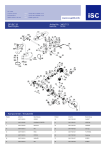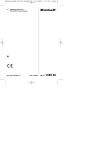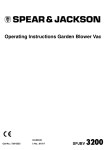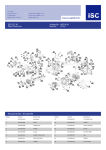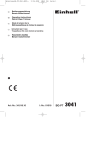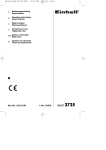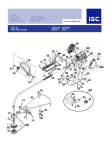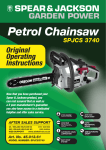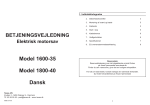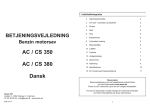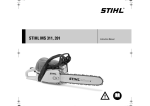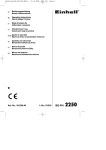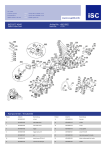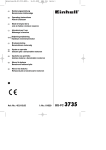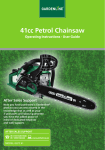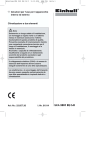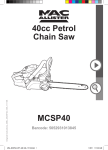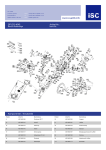Download Warning - Einhell
Transcript
Operating instruction Petrol Chain Saw " WARNING! PLEASE READ THESE INSTRUCTIONS BEFORE OPERATING THIS UNIT" "KEEP THIS MANUAL FOR FUTURE REFERENCE” � SPJCS 4040 Read and follow the operating instructions and safety information before using for the first time. Always wear PPE (Personal Protective Clothing). Wear a safety helmet, eye and ear protection! Wear safety shoes! Wear gloves! 2 Helpline No: UK 0151 649 1500 / IRE 189 094 6244 Please read these instructions carefully before installing and operating the petrol motor scythe! Petrol Engine Quick Start Guide Ensure correct fuel/oil mixture 50:1 STARTING 1. Set the On/Off switch to “On (I)” to start the machine. 2. Pull out the throttle lever until it locks. 3. Push the primer bulb 10 times. 4. Place saw on a firm, flat surface. Hold saw firmly as shown. Pull starter rapidly 2 times. Beware of moving chain! 5. Push in the throttle lever as far as it will go . Note - the amount of Choke will vary slightly depending on the weather conditions, a small amount of experimentation is advised. 6. Hold saw firmly and pull starter rapidly 4 times. Engine should start. 7. Let the engine run for 10 seconds to warm up. Press the throttle lever briefly, the engine will go to “idling” speed. Note - this quick start guide is intended for experienced users who have already assembled the tool, please refer to the manual for details. If machine does not start after minimum 6 pulls on starter cord refer to petrol Engine Q & A on page 21. 3 Helpline No: UK 0151 649 1500 / IRE 189 094 6244 6 1 8 7 11 1 2 10 3 9 5 17 4 14 12 13 20 18 15 19 2 16 3A 3B A B 3C 3D F D 24 E 4 Helpline No: UK 0151 649 1500 / IRE 189 094 6244 G 4A A 4B D B C 5 6 A C B D 7A 7B A 8 9A C I A 0 A B 5 Helpline No: UK 0151 649 1500 / IRE 189 094 6244 9B 9C 9D B C 9E D 10 11 B B C A A 12 13 14 A B 6 Helpline No: UK 0151 649 1500 / IRE 189 094 6244 15 16A 16B 17 18A A 16C A A B B C 18B 20 19 D A C 21A 21B 7 Helpline No: UK 0151 649 1500 / IRE 189 094 6244 22 23 24 26 27 25 A 2 1 28 3 4 29 5 7 6 30 A B A 1 2 A A B 3 4 C 8 Helpline No: UK 0151 649 1500 / IRE 189 094 6244 Table of contents Page 1. 2. 3. 4. 5. 6. 7. 8. 9. 10. 11. 12. 13. 10 12 12 12 12 13 14 16 16 18 19 19 20 General safety instructions Layout Proper use Environmental protection Installation Before starting the machine Operation Technical data Maintenance Storage Waste disposal Ordering spare parts Troubleshooting 9 Helpline No: UK 0151 649 1500 / IRE 189 094 6244 Packaging The unit is supplied in packaging to prevent it from being damaged in transit. The raw materials in this packaging can be reused or recycled. When using the equipment, a few safety precautions must be observed to avoid injuries and damage. Read the operating instructions carefully and comply with them at all times. It is important to consult these instructions in order to acquaint yourself with the unit, its proper use and the important safety regulations. Keep this manual in a safe place, so that the information is available at all times. If you give the equipment to any other person, make sure that you pass on these operating instructions as well. We can accept no liability for damage or accidents which arise due to non-compliance with these instructions. 1. General safety instructions 1.1 Explanation of the symbols and warning signs on the machine (Fig. 27) 1. Read the user manual before using the machine 2. On all jobs performed with the saw you must always wear safety goggles to guard your eyes from flying materials/objects and a sound-proof helmet, ear plugs or the like to protect your hearing. Wear a safety helmet if there is a risk of objects falling on you from above. 3. Wear gloves to protect your hands. 4. Wear safety shoes to protect your feet. 5. Warning! Danger! 6. Make sure that the chain brake is released. Pull back the handle/chain brake before operating. 7. Noise emission complies with Directive 2000/14/EC! 1.2 Explanation of the pictograms for handling on the machine (Fig. 28) A safety sign is fitted to the chain saw’s fan filter cover. This label, along with the safety instructions on these pages, should be carefully read before attempting to operate this unit. Important: Picture 1/2/3 Warns about a dangerous method of working that must not be used. Picture 4 RECOMMENDED Recommended operation for safe sawing. IMPORTANT: 1. Beware of recoil. 2. Do not hold the saw in one hand. 3. Avoid contact with the tip of the rail (chain return point). RECOMMENDED 4. Hold the saw firmly with both hands. Place your right hand on the rear handle and your left hand on the front handle. 1.3 Kickback safety precautions Warning: Kickback can lead to dangerous loss of control of the chain saw and result in serious or fatal injury to the saw operator or to anyone standing close by. Always be alert. Rotational kickback and pinch-kickback are major chain saw operational dangers and the leading cause of most accidents. KICKBACK may occur when the NOSE or TIP of the guide bar touches an object, or when wood closes in and pinches the saw chain in the cut. Tip contact in some cases may cause a lightning-fast reverse reaction, kicking the guide bar up and back toward the operator. PINCHING the saw chain along the BOTTOM of the guide bar may PULL the saw forward away from the operator. PINCHING the saw chain along the TOP of the guide bar may PUSH the guide bar rapidly back toward the operator. Any of these reactions may cause you to lose control of the saw, which could result in serious personal injury. Beware of the following: Rotary recoil (Fig. 29) A = Recoil distance B = Recoil reaction zone Impact/Jamming recoil and pulling reactions (Fig. 30) A = Pull B = Solid objects C = Push To prevent pulling reactions, place the wood you wish to cut against the claw stop. Use the claw stop as a pivot point during cutting. 1.4 Safety Instructions Warning: When using petrol tools, basic safety precautions, including the following, should always be followed to reduce the risk of serious personal injury and/or damage to the unit. 10 Helpline No: UK 0151 649 1500 / IRE 189 094 6244 Read all these instructions before operating this product and save these instructions. 1. DO NOT operate a chain saw with one hand! Serious injury to the operator, helpers, bystanders, or any combination of these persons may result from one-handed operation. A chain saw is intended for two-handed use. 2. Do NOT use the saw if you are tired, ill or under the influence of alcohol and/or drugs. 3. Use safety footwear, snug-fitting clothing, protective gloves, and eye, hearing and head protection devices. 4. Use caution when handling fuel. Move the chain saw at least 10 feet (3m) from the fueling point before starting the engine. 5. DO NOT allow other persons to be near when starting or cutting with the chain saw. Keep bystanders and animals out of the work area. 6. DO NOT start cutting until you have a clear work area, secure footing, and a planned retreat path from the falling tree. 7. Keep all parts of your body away from the saw chain when the engine is running. 8. Before you start the engine, make sure that the saw chain is not contacting anything. 9. Carry the chain saw with the engine stopped, the guide bar and saw chain to the rear, and the exhaust away from your body. 10. NEVER use a chainsaw which is damaged, incorrectly set or incompletely and loosely assembled. Make sure that the chainsaw stops when the chain brake is applied. 11. Shut off the engine before setting the chain saw down. 12. Use extreme caution when cutting small size brush and saplings because slender material may catch the saw chain and be whipped toward you or pull you off balance. 13. When cutting a limb that is under tension, be alert for springback so that you will not be struck when the tension in the wood fibers is released. 14. Keep the handles dry, clean, and free of oil or fuel mixture. 15. Operate the chain saw only in well-ventilated areas. 16. DO NOT operate a chain saw in a tree unless you have been specifically trained to do so. 17. All chain saw service, other than the items listed in the user manual safety and maintenance instructions, should be performed by competent chain saw service personnel. 18. When transporting your chain saw, use the appropriate guide bar scabbard. 19. DO NOT operate your chain saw near or around flammable liquids or gases whether in or out of doors. An explosion and/or fire may result. 20. Do not tank fuel, oil or lubrication when the engine of chain saw is running. 21. USE THE RIGHT TOOL: Cut wood only. Do not use the chain saw for purposes for which it was not intended. For example, do not use the chain saw for cutting plastic, masonry, or non building materials. 22. The engine will create toxic exhaust fumes as soon as the engine is started. Never work in enclosed rooms or in rooms with poor ventilation. Note: The following appendix is primarily for the end user or occasional user. The chainsaw is designed for occasional use by home owners, garden owners and campers and is for general work such as stumpgrubbing, cutting firewood, etc. It is not designed for lengthy use. If it is used for a lengthy period, the vibrations it causes in the hands of the user may result in circulation problems (white finger syndrome). Kickback may occur when the nose or tip of the guide bar touches an object, or when the wood closes in and pinches the saw chain in the cut. If the bar tip contacts, it may cause a lightning-fast reverse reaction, kicking the guide bar up and back towards the operator. Pinching the saw chain along the top of the guide bar may push the guide bar rapidly back towards the operator. Either of these reactions may cause you to loose control of the saw, which could result in serious personal injury. Do not rely exclusively upon the safety devices built into your saw. As a chain saw user, you should take several steps to keep your cutting jobs free from accident or injury. 1. With a basic understanding of kickback, you can reduce or eliminate the element of surprise. Sudden surprise contributes to accidents. 2. Keep a good firm grip on the saw with both hands, the right hand on the rear handle, and the left hand on the front handle, when the engine is running. Use a firm grip with thumbs and fingers encircling the chain saw handles. A firm grip will help you reduce kickback and maintain control of the saw. Don’t let go. 3. Make sure that the area in which you are cutting is free from obstructions. Do not let the nose of the guide bar contact a log, branch, or any other obstruction which could be hit while you are operating the saw. 4. Cut at high engine speeds. 5. Do not overreach or cut above shoulder height. 6. Follow manufacturer’s sharpening and maintenance instructions for the saw chain. 7. Only use replacement bars and chains specified by the manufacturer or the equivalent. 11 Helpline No: UK 0151 649 1500 / IRE 189 094 6244 2. Layout (Fig. 1) 1. 2. 3. 4. 5. 6. 7. 8. 9. 10. 11. 12. 13. 14. 15. 16. 17. 18. 19. 20. Chain bar Saw chain Chain tensioning screw Stop claw Chain brake lever / front hand guard Front handle Starter handle Spark plug (under the air filter cover) Air filter cover Stop switch Safety lock Oil tank cap Fan housing Fuel tank cap Rear handle / bootstrap Chain guard Choke / (carburetor setting) Bar fastening nut Throttle lever Chain catch appropriate training. The manufacturer cannot be held liable for damage caused by improper or incorrect usage. Please note that our equipment has not been designed for use in commercial, trade or industrial applications. Our warranty will be voided if the machine is used in commercial, trade or industrial businesses or for equivalent purposes. 4. Environmental protection Dispose of soiled maintenance material and operating materials at the appropriate collection point. Recycle packaging material, metal and plastics. 5. Installation Important: Do not start the engine until the saw is fully assembled. Safety features (Fig.1) 2 LOW KICKBACK SAW CHAIN helps significantly reduce kickback, or the intensity of kickback, due to specially designed depth gauges and guard links. 5 CHAIN BRAKE LEVER / HAND GUARD protects the operator’s left hand in the event it slips off the front handle while saw is running. 5 CHAIN BRAKE is a safety feature designed to reduce the possibility of injury due to kickback by stopping a moving saw chain in milliseconds. It is activated by the CHAIN BRAKE lever. 10 STOP SWITCH immediately stops the engine when tripped. Stop switch must be pushed to ON position to start or restart engine. 11 SAFETY TRIGGER prevents accidental acceleration of the engine. Throttle trigger (19) cannot be squeezed unless the safety latch is depressed. 20 CHAIN CATCHER reduces the danger of injury in the event saw chain breaks or derails during operation. The chain catcher is designed to intercept a whipping chain. Important: Wear protective gloves at all times Note: Study your saw and be familiar with its parts. 5.2 To install saw chain 1. Spread chain out in a loop with cutting edges (A) pointing CLOCKWISE around loop (Fig. 4A). 2. Slip the chain around the sprocket (B) behind the clutch (C). Make sure the links fit between the sprocket teeth (Fig. 4B). 3. Guide the drive links into the groove (D) and 3. Proper use The chain is designed exclusively for sawing wood. You may only fell trees if you have received the when handling the chain. 5.1 Fit the chain bar To ensure that the bar and the chain are supplied with oil, USE ONLY THE ORIGINAL BAR. The oiling hole (Fig. 2/Item A) must be kept clear of dirt and any build-up of residue. 1. Make sure the Chain brake lever is pulled back into the DISENGAGED position (Fig. 3A) 2. Remove the two bar fastening nuts (B). Remove the cover (Fig. 3B). Important: When assembling for the first time, the material fitted to provide protection during transportation (Fig. 3C/Item 24) must be removed first. 3. Using a screwdriver, run the adjustment screw (D) COUNTERCLOCKWISE until the TANG (E) (projecting prong) is to the end of its travel toward the clutch drum and sprocket (Fig. 3C). 4. Fit the open end of the chain bar over the die bar pins (F) (Fig. 3D). 12 Helpline No: UK 0151 649 1500 / IRE 189 094 6244 around the end of the bar (Fig. 4B). Caution: A new saw chain stretches, requiring NOTE: The saw chain may droop slightly on the lower part of bar. This is normal. adjustment after as few as 5 cuts. This is normal with a new chain, and the interval between future adjustments will lengthen quickly. 4. Pull the chain bar forward until the chain is closely seated. Make sure that all the drive links are in the groove of the bar. 5. Fit the clutch cover and fasten it with 2 screws. Make sure that the pivot (Fig. 3C/Item E) fits into the chain bar (Fig. 3D/Item G). The chain must not slip off the bar when you do this. Tighten the two nuts by hand and then follow the instructions for adjusting the tension in ADJUSTING THE CHAIN TENSION. Caution: If the saw chain is TOO LOOSE or TOO 5.3 Saw chain tension adjustment Proper tension of saw chain is extremely important and must be checked before starting, as well as during any cutting operation. Taking the time to make needed adjustments to the saw chain will result in improved cutting performance and prolonged chain life. Warning: Always wear heavy duty gloves when handling saw chain or making saw chain adjustments. 1. Before adjusting the chain tension screw you must slacken the 2x retaining nuts. Otherwise this will damage tension screw. 2. Hold nose of guide bar up and turn adjustment screw (D) CLOCKWISE to increase chain tension. Turning screw COUNTERCLOCKWISE will decrease amount of tension on chain. Ensure the chain fits snugly all the way around the guide bar (Fig. 5). 3. After making adjustment, and while still holding nose of bar in the uppermost position, tighten the bar retaining nuts securely. Chain has proper tension when it has a snug fit all around and can be pulled around by gloved hand. NOTE: If chain is difficult to rotate on guide bar or if it binds, too much tension has been applied. This requires minor adjustment as follows: A. Loosen the bar retaining nut so they are finger tight. Decrease tension by turning the bar adjustment screw COUNTERCLOCKWISE slowly. Move chain back and forth on bar. Continue to adjust until chain rotates freely, but fits snugly. Increase tension by turning bar adjustment screw CLOCKWISE. B. When saw chain has proper tension, hold nose of bar in the uppermost position and tighten the bar retaining nut securely. TAUT, the drive wheel, chain bar, chain and crank shaft bearing will suffer premature wear. Fig. 6 shows the correct tension A (when cold) and tension B (when warm). Fig. C shows a chain that is too loose. 6. Before starting the machine 6.1 Chain break mechanical test Your chain saw is equipped with a Chain brake that reduces possibility of injury due to kickback. The brake is activated if pressure is applied against brake lever when, as in the event of kickback, operator’s hand strikes the lever. When the brake is actuated, chain movement stops abruptly. Warning: The purpose of the chain brake is to reduce the possibility of injury due to kickback; however, it cannot provide the intended measure of protection if the saw is operated carelessly. Always test the chain brake before using your saw and periodically while on the job. To test chain brake 1. The Chain brake is DISENGAGED (chain can move) when BRAKE LEVER IS PULLED BACK AND LOCKED (Fig. 7A). 2. The chain brake is ENGAGED (the chain is locked) when the brake lever is pulled forward and the mechanism (Fig. 7B/Item A) can be seen. It should not be possible to move the chain (Fig. 7B). NOTE: The brake lever should snap into both positions. If strong resistance is felt, or lever does not move into either position, do not use your saw. Take it immediately to a professional Service Center for repair. 6.2 Fuel and lubrication Fuel Use regular grade unleaded fuel mixed with 50:1 custom 2-cycle engine oil for best results. Mixing fuel Mix fuel with 2 cycle oil in an approved container. Shake gently and ensure thorough mix. 13 Helpline No: UK 0151 649 1500 / IRE 189 094 6244 Warning: Never use straight fuel in your unit. This will cause permanent engine damage and void the manufacturer’s warranty for that product. Never use a fuel mixture that has been stored for over 90 days. Warning: If 2-cycle lubricant is to be used, it must be a premium grade oil for 2-cycle air cooled engines mixed at a 50:1 ratio. Do not use any 2-cycle oil product with a recommended mixing ratio of 100:1. If insufficient lubrication is the cause of engine damage, it voids the manufacturer’s engine warranty for that occurrence. 2. Pull out the throttle lever (B) (Fig. 9B) until it locks. 3. Push the primer bulb (C) 10 times (Fig. 9C). 4. Place saw on a firm, flat surface. Hold saw firmly as shown. Pull starter rapidly 2 times. Beware of moving chain! (Fig.9D) 5. Push in the throttle lever (B) as far as it will go (Fig. 9B). 6. Hold saw firmly and pull starter rapidly 4 times. Engine should start (Fig. 9D). 7. Let the engine run for 10 seconds to warm up. Press the throttle lever (D) briefly, the engine will go to “idling” speed (Fig. 9E). If engine failed to start, repeat these instructions. Important: Always pull the starter cable slowly until you feel the initial resistance before you then pull it quickly to start the engine. Do not allow the starter cable to whip back of its own accord. Fuel and Oil Mix 50:1 Oil Only Recommended fuels Some conventional fuels are being blended with oxygenates such as alcohol or an ether compound to meet clean air standards. Your engine is designed to operate satisfactorily on any fuel intended for automotive use including oxygenated fuel. It is recommended to use unleaded petrol as fuel. Lubrication of chain and chain bar Whenever you refill the fuel tank with petrol you must also top up the level of chain oil in the chain oil tank. It is recommended to use standard chain oil. 7.2 Restarting a warm engine 1. Make sure the switch is in the ON position. 2. Pull the starter rope rapidly 6 times. The engine should start. 7.3 To stop engine 1. Release trigger and allow engine to return to idle speed. 2. Move STOP switch down to stop engine. Note: To stop the engine in an emergency, activate the chain brake and switch the ON/OFF switch to “Stop (0)”. 7.4 General cutting instructions IMPORTANT: Felling trees is prohibited without Engine pre-start checks Warning: Never start or operate the saw unless the necessary training! the bar and chain are properly installed. 1. Fill the fuel tank (A) with correct fuel mixture (Fig. 8). 2. Fill the oil tank (B) with chain oil (Fig. 8). 3. Be certain the chain brake is disengaged (C) before starting unit (Fig. 8). Felling Felling is the term for cutting down a tree. Small trees up to 6-7 inches (15-18cm) in diameter are usually cut in a single cut. Larger trees require notch cuts. Notch cuts determine the direction the tree will fall. Once you have filled the chain and oil tank, tighten the tank cover securely by hand. Do not use any tools to do so. Warning: A retreat path (A) should be planned and cleared as necessary before cuts are started. The retreat path should extend back and diagonally to the rear of the expected line of fall, as illustrated in Fig. 11. Warning: If felling a tree on sloping ground, the 7. Operation 7.1 Starting the engine 1. Set the On/Off switch (A) to “On (I)” to start the machine (Fig. 9A). chain saw operator should keep on the uphill side of the terrain, as the tree is likely to roll or slide downhill after it is felled. 14 Helpline No: UK 0151 649 1500 / IRE 189 094 6244 NOTE: Direction of fall (B) is controlled by the notching cut. Before any cuts are made, consider the location of larger branches and natural lean of the tree to determine the way the tree will fall (Fig. 11). Warning: Do not cut down a tree during high or changing winds or if there is a danger to property. Consult a tree professional. Do not cut down a tree if there is a danger of striking utility wires; notify the utility company before making any cuts. General guidelines for felling trees (Fig. 12) Normally felling consists of 2 main cutting operations, notching (C) and making the felling cut (D). Start making the upper notch cut (C) on the side of the tree facing the felling direction (E). Be sure you don t make the lower cut too deep into the trunk. The notch (C) should be deep enough to create a hinge (F) of sufficient width and strength. The notch should be wide enough to direct the fall of the tree for as long as possible. Warning: Never walk in front of a tree that has been notched. Make the felling cut (D) from the other side of the tree and 1.5 - 2.0 inches (3-5 cm) above the edge of the notch (C). Never saw completely through the trunk. Always leave a hinge. The hinge guides the tree. If the trunk is completely cut through, control over the felling direction is lost. Insert a wedge or felling lever in the cut well before the tree becomes unstable and starts to move. This will prevent the guidebar from binding in the felling cut if you have misjudged the falling direction. Make sure no bystanders have entered the range of the falling tree before you push it over. Warning: Before making the final cut, always recheck the area for bystanders, animals or obstacles. Felling cut 1. Use wooden or plastic wedges (A) to prevent binding the bar or chain (B) in the cut. Wedges also control felling (Fig. 13). 2. When diameter of wood being cut is greater than the bar length, make 2 cuts as shown (Fig. 14). Warning: As the felling cut gets close to the hinge, the tree should begin to fall. When tree begins to fall, remove saw from cut, stop engine, put chain saw down, and leave area along retreat path (Fig. 11). branches from a fallen tree. Do not remove supporting limbs (A) until after the log is bucked (cut) into lengths (Fig. 15). Branches under tension should be cut from the bottom up to avoid binding the chain saw. Warning: Never cut tree limbs while standing on tree trunk. Bucking Bucking is cutting a fallen log into lengths. Make sure you have a good footing and stand uphill of the log when cutting on sloping ground. If possible, the log should be supported so that the end to be cut off is not resting on the ground. If the log is supported at both ends and you must cut in the middle, make a downward cut halfway through the log and then make the undercut. This will prevent the log from pinching the bar and chain. Be careful that the chain does not cut into the ground when bucking as this causes rapid dulling of the chain. When bucking on a slope, always stand on the uphill side. 1. Log supported along entire length: Cut from top (overbuck), being careful to avoid cutting into the ground (Fig. 16A). 2. Log supported on 1 end: First, cut from bottom (underbuck) 1/3 diameter of log to avoid splintering. Second, cut from above (overbuck) to meet first cut and avoid pinching (Fig. 16B). 3. Log supported on both ends: First, overbuck 1/3 diameter of log to avoid splintering. Second, underbuck to meet first cut and avoid pinching (Fig. 16C). Note: The best way to hold a log while bucking is to use a sawhorse. When this is not possible, the log should be raised and supported by the limb stumps or by using supporting logs. Be sure the log being cut is securely supported. Bucking using a sawhorse (Fig. 17) For personal safety and ease of cutting, the correct position for vertical bucking is essential (Fig. 17). A. Hold the saw firmly with both hands and keep the saw to the right of your body while cutting. B. Keep the left arm as straight as possible. C. Keep weight on both feet. Caution: When working with the saw, always make sure that the saw chain and chain bar are sufficiently lubricated. Limbing Limbing a tree is the process of removing the 15 Helpline No: UK 0151 649 1500 / IRE 189 094 6244 8. Technical data 40.1 cm3 1.5 kW Engine displacement Maximum engine capacity Bar length Cutter rail length 39 cm 16” (40 cm) Chain pitch (3/8”), 10 mm Chain thickness (0.05”), 1.27 mm Idling speed 3200 rpm Maximum speed with cutting equipment 11000 rpm Tank capacity 400 ml Oil tank capacity Anti-vibration function Chain wheel teeth 210 ml Yes 6 x 9.525 mm Chain brake Clutch Yes Yes Automatic chain lubrication Low-kickback chain Net weight without chain and chain bar Net weight (dry) Fuel consumption (specific) Yes Yes 4.5 kg 5.3 kg 560 g / kWh LpA sound pressure level 104 dB(A) LWA sound power level 112 dB(A) Vibration ahv (front handle) max. 6.82 m/s2 Vibration ahv (rear handle) max. 10.11 m/s2 Chain type OREGON (160SDEA041) Bar type OREGON (91VG057) Spark plug L8RTF 9. Maintenance Warning: All maintenance work on the chainsaw apart from the work described in this manual may only be carried out by authorized after-sales service personnel. 9.1 Chain brake operational test Test the chain brake periodically to ensure proper function. Perform a chain brake test prior to initial cutting, following extensive cutting, and definitely following any Chain brake service. Test chain brake as follows (Fig. 10) : 1. Place saw on a clear, firm, flat surface. 2. Start engine. 3. Grasp the rear handle (A) with your right hand. 4. With your left hand, hold the front handle (B) [not chain brake lever (C)] firmly. 5. Squeeze the throttle trigger to 1/3 throttle, then immediately activate the chain brake lever (C). Warning: Activate the chain brake slowly and deliberately. Keep the chain from touching anything; don’t let the saw tip forward. 6. Chain should stop abruptly. When it does, immediately release the throttle trigger. Warning: If chain does not stop, turn engine off and take your unit to the nearest Talon Authorized Service Center for service. 7. If chain brake functions properly, turn the engine off and return the chain brake to the DISENGAGED position. 9.2 Air filter Warning: Never operate saw without the air filter. Dust and dirt will be drawn into engine and damage it. Keep the air filter clean! The air filter must be cleaned or replaced after every 20 hours of service. Cleaning the air filter (Fig. 18A/18B) 1. Remove the top cover (A) by undoing the cover fastening screw (B) on the cover. You can then remove the cover (Fig. 18A). 2. Lift out the air filter (C) (Fig. 18B). 3. Clean air filter. Wash filter in clean, warm, soapy water. Rinse in clear, cool water. Air dry completely. Note: It is advisable to have a supply of spare filters. 4. Insert the air filter. Fit the cover for the engine/air filter. Make sure that the cover fits perfectly when you do so. Tighten the fastening screw for the cover. 9.3 Fuel filter Warning:Never use the saw without a fuel filter. After 100 hours in operation the fuel filter should be cleaned or, in case of damage, replaced. Be sure to empty the fuel tank before changing the filter. 1. Remove the fuel tank cap. 2. Bend a piece of soft wire. 3. Reach into fuel tank opening and hook fuel line. Carefully pull the fuel line toward the opening until you can reach it with your fingers. Note: Do not pull hose completely out of tank. 4. Lift filter (A) out of tank (Fig. 19). 5. Pull off the filter with a twist and clean it; if the 16 Helpline No: UK 0151 649 1500 / IRE 189 094 6244 filter is damaged, dispose of it. 6. Insert a new filter. Place one end of the filter into the tank opening. Make sure that the filter is seated in the lower corner of the tank. If necessary, use a long screwdriver to move the filter to its correct position, taking care not to damage in the process. 7. Fill tank with fresh fuel / oil mixture. See Section Fuel and Lubrication. Install fuel cap. 10 hours of use or once a week, which ever occurs first. Always thoroughly clean guide bar sprocket tip before lubrication. 9.4 Spark plug (Fig. 18B) handling the bar and chain. 1. Set the On/Off switch to Stop (0)”. 2. Clean the guide bar sprocket tip. 3. Using the Lube Gun (optional), insert needle nose into the lubrication hole and inject grease until it appears at outside edge of sprocket tip (Fig .20). 4. Rotate saw chain by hand. Repeat lubrication procedure until the entire sprocket tip has been greased. Warning: To ensure that the saw’s engine retains its power, the spark plug must be clean and have the correct electrode gap (0.6 mm). The spark plug must be cleaned or replaced after every 20 hours of service. 1. Set the On/Off switch to Stop (0)”. 2. Remove the top cover (A) by undoing the cover fastening screw (B) on the cover. You can then remove the cover (Fig. 18A). 3. Disconnect the ignition cable (D) from the spark plug by pulling and twisting it simultaneously (Fig. 18B). 4. Remove the spark plug using a spark plug wrench. DO NOT USE ANY OTHER TOOLS. 5. Clean the spark plug with a copper wire brush or fit a new one. 9.5 Carburetor setting The carburetor has been set to its perfect adjustment at the factory. If it requires adjusting, take the saw to your nearest authorized after-sales service outlet. 9.6 Chain bar maintenance Regular lubrication of the chain bar (guide rail for the chain and teeth) is essential. The chain bar needs the maintenance described in the following section in order for the saw to work at an optimum level of performance. Caution: The sprocket tip on your new saw has been pre-lubricated at the factory. Failure to lubricate the guide bar sprocket tip as explained below will result in poor performance and seizure, voiding the manufacturer’s warranty. Tools for lubrication The Lube Gun is recommended for applying grease to the guide bar sprocket tip. The Lube Gun is equipped with a needle nose tip which is necessary for the efficient application of grease to the sprocket tip. To lubricate sprocket tip Lubrication of the sprocket tip is recommended after Note: The saw chain does not have to be removed in order to lubricate the teeth of the chain bar. Lubrication is possible during work, with the engine switched off. Warning: Wear heavy duty work gloves when Most guide bar problems can be prevented merely by keeping the chain saw well maintained. Insufficient guide bar lubrication and operating the saw with chain that is TOO TIGHT will contribute to rapid bar wear. To help minimize bar wear, the following guide bar maintenance procedures are recommended. Warning: Always wear protective gloves during maintenance operations. Do not carry out maintenance when the engine is hot. Turning the chain bar The bar should be reversed every 8 working hours to ensure uniform wear. Keep the bar groove and lubrication hole clean using the bar groove cleaner supplied optional. (Fig. 21A) Check the bar rails frequently for wear and, if necessary, remove the burs and square-up the rails using the flat file. (Fig. 21B) Warning: Never fit a new chain to a worn chain bar. Oil passages Oil passages on the bar should be cleaned to ensure proper lubrication of the bar and chain during operation. Note: The condition of the oil passages can be easily checked. If the passages are clear, the chain will automatically give off a spray of oil within seconds of starting the saw. Your saw is equipped with an automatic oiler system. Automatic chain lubrication. The chain saw is equipped with an automatic oil 17 Helpline No: UK 0151 649 1500 / IRE 189 094 6244 lubrication system with a toothed wheel drive. It automatically supplies the bar and the chain with the right quantity of oil. The moment the engine is accelerated, the oil also starts to flow through the bar plate more quickly as well. The chain lubrication system has been set to its perfect adjustment at the factory. If it requires adjusting, take the saw to your nearest authorized after-sales service outlet. A setting screw for adjusting the chain lubrication (Fig. 26/ Item A) is located on the underside of the chain saw. Turning the screw counter-clockwise increases the chain lubrication, turning it clockwise decreases the chain lubrication. To check the chain lubrication, hold the chain saw, with the chain, over a piece of paper and run it at full speed for a few seconds. You will be able to judge the set amount of oil from the paper. 9.7 Chain maintenance Chain sharpening Chain sharpening requires special tools to ensure that cutters are sharpened at the correct angle and depth. For the inexperienced chain saw user, we recommend that the saw chain be professionally sharpened by the nearest professional Service Center. If you feel comfortable sharpening your own saw chain, special tools are available from the professional Service Center. Chain sharpening (Fig. 23) Sharpen the chain using protective gloves and a round file of ø3/16” (4.8mm). Always sharpen the cutters only with outward strokes (Fig. 23) observing the values given in Fig. 22. After sharpening, the cutting links must all have the same width and length. Warning: A sharp chain produces well-defined chips. When your chain starts to produce sawdust, it is time to sharpen. After the blades have been sharpened 3-4 times, check the height of the depth limiter and if necessary lower it with a flat file and then round off the front corner (Fig. 24). Chain tension Check the chain tension frequently and adjust as often as necessary to keep the chain snug on the bar, but loose enough to be pulled around by hand. (see also point 5.3) Breaking in a new saw chain A new chain and bar will need chain readjustment after as few as 5 cuts. This is normal during the break-in period, and the interval between future adjustments will begin to lengthen quickly. Warning: Never have more than 3 links removed from a loop of chain. This could cause damage to the sprocket. Chain lubrication Always make sure the automatic oiler system is working properly. Keep the oil tank filled with Chain, Bar and Sprocket Oil. Adequate lubrication of the bar and chain during cutting operations is essential to minimize friction with the guide bar. Never starve the bar and chain of lubricating oil. Running the saw dry or with too little oil will decrease cutting efficiency, shorten saw chain life, cause rapid dulling of chain, and lead to excessive wear of bar from overheating. Too little oil is evidenced by smoke or bar discoloration. 10. Storage Caution: Never put a chain saw into storage for longer than 30 days without carrying out the following steps. Storing a chain saw Storing a chain saw for longer than 30 days requires storage maintenance. Unless the storage instructions are followed, fuel remaining in the carburetor will evaporate, leaving gum-like deposits. This could lead to difficult starting and result in costly repairs. 1. Remove the fuel tank cap slowly to release any pressure in tank. Carefully drain the fuel tank. 2. Start the engine and let it run until the unit stops to remove fuel from carburetor. 3. Allow the engine to cool (approx. 5 minutes). 4. Remove the spark plug (9.4). 5. Pour 1 teaspoon of clean 2-cycle oil into the combustion chamber. Pull starter rope slowly several times to coat internal components. Replace spark plug (Fig. 25). Note: Store the unit in a dry place and away from possible sources of ignition such as a furnace, gas hot water heater, gas dryer, etc. 18 Helpline No: UK 0151 649 1500 / IRE 189 094 6244 Puttig the saw back into operation 1. Remove spark plug (see also point 9.4). 2. Pull starter rope briskly to clear excess oil from combustion chamber. 3. Clean the spark plug and check that the electrode gap is correct. 4. Prepare unit for operation. 5. Fill fuel tank with proper fuel / oil mixture. See Fuel and Lubrication Section. 11. Waste disposal The equipment and its accessories are made of various types of material, such as metal and plastic. Defective components must be disposed of as special waste. Ask your dealer or your local council. 12. Ordering replacement parts Please quote the following data when ordering replacement parts: Type of machine Article number of the machine Identification number of the machine Replacement part number of the part required For our latest prices and information please go to www.isc-gmbh.info Helpline Numbers: UK: 0151 649 1500 IRE: 189 094 6244 19 Helpline No: UK 0151 649 1500 / IRE 189 094 6244 13. Troubleshooting Problem Probable cause Unit won’t start or starts but will not Incorrect starting procedures. run. Corrective Action Follow instructions in the User Manual or refer ti starting procedure check list on page 21 Incorrect carburetor mixture adjustment setting. Have carburetor adjusted by an Authorized Service Center. Fouled spark plug. Clean / gap or replace plug. Fuel filter plugged. Replace fuel filter. Chain brake is on. Put Chain brake in off position. Incorrect lever position on choke. Move to RUN position. Dirty air filter. Remove, clean and reinstall filter. Incorrect carburetor mixture adjustment setting. Have carburetor adjusted by an Authorized Service Center. Engine hesitates. Incorrect carburetor mixture adjustment setting. Have carburetor adjusted by an Authorized Service Center. No power under load. Incorrectly gapped spark plug. Clean / gap or replace plug. Runs erratically. Incorrect carburetor mixture adjustment setting. Have carburetor adjusted by an Authorized Service Center. Smokes excessively. Incorrect fuel mixture. Use properly mixed fuel (50:1 mixture). Poor performance when operated Blunt chain Sharpen or replace the chain Loose chain Tension the chain Empty petrol tank Fill up the petrol tank Fuel filter in the wrong position in the tank Completely fill the petrol tank or or re-position the fuel filter in the petrol tank Empty oil tank for the chain Top up the oil tank for the chain Oil lubrication openings moved Clean the oil lubrication hole in the cutter bar (Fig. 2/Item A) Clean the groove in the cutter bar Unit starts, but engine has low power. Engine dies Insufficient chain lubrication (the cutter rail and chain get hot) 20 Helpline No: UK 0151 649 1500 / IRE 189 094 6244 Helpline No: UK 0151 649 1500 / IRE 189 094 6244 21 If after trying all of the above procedures please call the help line for further assistance Konformitätserklärung k t p m O U q T B Q Z z erklärt folgende Konformität gemäß EU-Richtlinie und Normen für Artikel declares conformity with the EU Directive and standards marked below for the article déclare la conformité suivante selon la directive CE et les normes concernant l’article verklaart de volgende conformiteit in overeenstemming met de EU-richtlijn en normen voor het artikel declara la siguiente conformidad a tenor de la directiva y normas de la UE para el artículo declara a seguinte conformidade de acordo com a directiva CE e normas para o artigo förklarar följande överensstämmelse enl. EUdirektiv och standarder för artikeln ilmoittaa seuraavaa Euroopan unionin direktiivien ja normien mukaista yhdenmukaisuutta tuotteelle erklærer herved følgende samsvar med EUdirektiv og standarder for artikkel заявляет о соответствии товара следующим директивам и нормам EC izjavljuje sljedeću uskladjenost s odredbama i normama EU za artikl. declarå urmåtoarea conformitate cu linia directoare CE μi normele valabile pentru articolul. ürün ile ilgili olarak AB Yönetmelikleri ve Normlar∂ gere©ince aμa©∂daki uygunluk aç∂kla mas∂n∂ sunar. ‰ËÏÒÓÂÈ ÙËÓ ·ÎfiÏÔ˘ıË Û˘Ìʈӛ· Û‡Ìʈӷ Ì ÙËÓ √‰ËÁ›· ∂∂ Î·È Ù· ÚfiÙ˘Ô ÁÈ· ÙÔ ÚÔ˚fiÓ ISC-GmbH · Eschenstraße 6 · D-94405 Landau/Isar C l j A X W e 1 . G 4 H E dichiara la seguente conformità secondo la direttiva UE e le norme per l’articolo attesterer følgende overensstemmelse i henhold til EU-direktiv og standarder for produkt prohlašuje následující shodu podle směrnice EU a norem pro výrobek. a következő konformitást jelenti ki a termékekre vonatkozó EU-irányvonalak és normák szerint pojasnjuje sledečo skladnost po smernici EU in normah za artikel. deklaruje zgodność wymienionego poniżej artykułu z następującymi normami na podstawie dyrektywy WE. vydáva nasledujúce prehlásenie o zhode podľa smernice EÚ a noriem pre výrobok. деклаpиpа следното съответствие съгласно диpективите и ноpмите на ЕС за пpодукта. заявляє про відповідність згідно з Директивою ЄС та стандартами, чинними для даного товару deklareerib vastavuse järgnevatele EL direktiivi dele ja normidele deklaruoja atitikti pagal ES direktyvas ir normas straipsniui izjavljuje sledeçi konformitet u skladu s odred bom EZ i normama za artikl Atbilstības sertifikāts apliecina zemāk minēto preču atbilstību ES direktīvām un standartiem Samræmisyfirl‡sing sta›festir eftirfarandi samræmi samkvæmt reglum Evfrópubandalagsins og stö›lum fyrir vörur Petrol Chain Saw SPJCS 4040 X 98/37/EC 87/404/EEC 2006/95/EC R&TTED 1999/5/EC 97/23/EC X X LWM = 110 dB; LWA = 114 dB P = 1,5 kW 95/54/EC: 89/336/EWG_93/68/EEC 90/396/EEC 2000/14/EC: X 97/68/EC: e11*97/68SA*2004/26*0747*01 89/686/EEC EN ISO 11681-1; EN 55012; KBV V; Intertek Deutschland GmbH, Nikolaus-Otto-Str. 13, 70771 Leinfelden Echterdingen 07SHW2982-01 Landau/Isar, den 08.10.2007 Weichselgartner General-Manager Art.-Nr.: 45.013.71 I.-Nr.: 01017 Subject to change without notice Frank Product-Management Archivierung: 4501370-28-4155050-07 22 Helpline No: UK 0151 649 1500 / IRE 189 094 6244 GUARANTEE CERTIFICATE Dear Customer, All of our products undergo strict quality checks to ensure that they reach you in perfect condition. In the unlikely event that your device develops a fault, please contact our service department at the address shown on this guarantee card. Of course, if you would prefer to call us then we are also happy to offer our assistance under the service number printed below. Please note the following terms under which guarantee claims can be made: 1. These guarantee terms cover additional guarantee rights and do not affect your statutory warranty rights. We do not charge you for this guarantee. 2. Our guarantee only covers problems caused by material or manufacturing defects, and it is restricted to the rectification of these defects or replacement of the device. Please note that our devices have not been designed for use in commercial, trade or industrial applications. Consequently, the guarantee is invalidated if the equipment is used in commercial, trade or industrial applications or for other equivalent activities. The following are also excluded from our guarantee: compensation for transport damage, damage caused by failure to comply with the installation/assembly instructions or damage caused by unprofessional installation, failure to comply with the operating instructions (e.g. connection to the wrong mains voltage or current type), misuse or inappropriate use (such as overloading of the device or use of non-approved tools or accessories), failure to comply with the maintenance and safety regulations, ingress of foreign bodies into the device (e.g. sand, stones or dust), effects of force or external influences (e.g. damage caused by the device being dropped) and normal wear resulting from proper operation of the device. The guarantee is rendered null and void if any attempt is made to tamper with the device. 3. The guarantee is valid for a period of 2 years starting from the purchase date of the device. Guarantee claims should be submitted before the end of the guarantee period within two weeks of the defect being noticed. No guarantee claims will be accepted after the end of the guarantee period. The original guarantee period remains applicable to the device even if repairs are carried out or parts are replaced. In such cases, the work performed or parts fitted will not result in an extension of the guarantee period, and no new guarantee will become active for the work performed or parts fitted. This also applies when an on-site service is used. Of course, we are also happy offer a chargeable repair service for any defects which are not covered by the scope of this guarantee or for units which are no longer covered. To take advantage of this service, please send the device to our service address. 23 Helpline No: UK 0151 649 1500 / IRE 189 094 6244 Argos Ltd 489-499 Avebury Boulevard Saxon Gate West Central Milton Keynes MK9 2NW Unit 5 Morpeth Wharf Twelve Quays Birkenhead, Wirral CH41 1LF Tel. 0151 6491500, Fax 0151 6491501 Helpline Numbers: UK: 0151 649 1500 IRE: 189 094 6244 Einhell UK Ltd The reprinting or reproduction by any other means, in whole or in part, of documentation and papers accompanying products is permitted only with the express consent of ISC GmbH. Technical changes subject to change EH 11/2007
























